Depiction of Foreigners
After the arrival of Commodore Matthew Perry in 1853, Japan opened up to international trade with Western countries for the first time after centuries of no direct exposure to the Western people or culture. Once Japan was opened up to the world, they were immediately introduced to unfamiliar people. The Japanese were fascinated with the Westerners and their culture. Their curiosity of Western people is demonstrated by the detailed depictions of foreign subjects and objects in various prints.
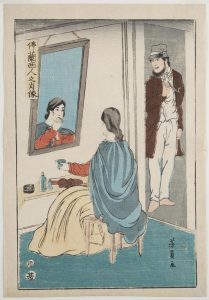
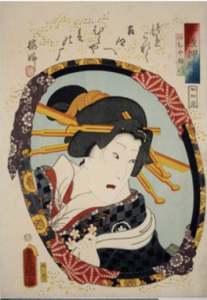
Many of the prints that depicted foreigners were based on Western newspapers or engravings. Looking at the images printed in newspapers Japanese artists reimagined Western clothing and behavior in their prints. One of the featured artists of the prints of foreign people, Utagawa Yoshitora, never saw foreign scenes but attempted to depict them based on other images that he saw of the Western people.
These prints done by Utagawa Yoshikazu display images of both a French couple (top left) where a man is standing by the door looking at a mirror and an English couple (bottom left) that seems to be walking their dog. The image of the couple displays an interesting trope that was often portrayed in Japanese prints of women looking into a mirror. Many Japanese prints focused on women and their beauty, which often included a female-centric depiction of their gracefulness. A theme of using mirrors as windows into a private space was also a common trope often employed to present alternate views in a work. The print by Utagawa Kunisada (top right), for example, depicts a Japanese woman peering into her reflection, made in 1861.
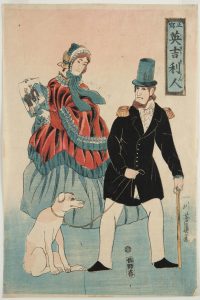
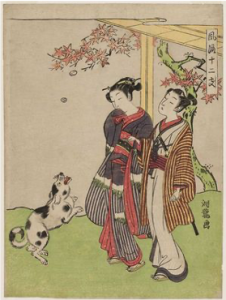
The image on the left of the English couple shows a woman holding a print and a man with a dog. The dog is of particular interest because many Japanese prints displayed dogs as free (right) while in this print there seems to be an emphasis on a leash depicting the dog as being a domesticated animal. In Japan in the 19th century, there was an arrival of Western canine imperialism which reshaped human-canine relations in Japan. During this period there was a transition to Western-style dog keeping practices by civilizing dogs and making them pets. Eventually in the 1870s this was a required task.
The image below to the right shows another trope often found in Japanese prints: the sharing of an umbrella. However, oftentimes in traditional Japanese art, the figures underneath the umbrella are both women. The man and a woman depicted in the print to the left share an umbrella. The symbol of an umbrella is often used to represent the idea of “togetherness” and unity. Depicting foreigners with a commonly used positive trope may show acceptance and admiration of these foreigners. Meanwhile, depicting both a man and a woman under the same umbrella suggests that the Japanese viewed Western women as more domineering than Japanese women and highlights the cultural differences.
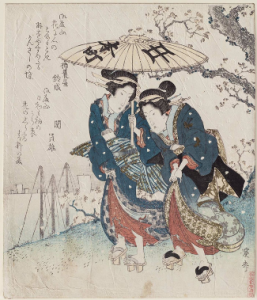
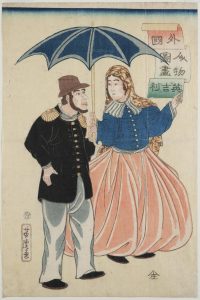
The print on the lowermost right illustrates an English woman on a horse looking down on an English man. This may have been a particularly surprising behavior to the Japanese, since only warriors were known to ride horses in Japan at the time1. This print further depicts the dominance of women over men, which is in stark contrast to to the typical Japanese woman’s position in the household. Similarly, the print at the bottom depicts a French woman in a beautiful, multiple-colored dress sitting on a high horse. The horse has a pink hue, which accentuates the French woman’s bold image.
Japanese bewilderment to the behavior of Western women is documented in an essay “My First Impressions of Foreigners” written by Takasu, a Japanese student in the 19th century: “When I saw a (Western) woman, I was very much surprised of her treating her husband like a servant; this was just contrary to our custom, that is, we supposed that women were inferior to men, and consequently a husband had the right to treat his wife as a maid”. A member of the 1860 Japanese mission to America stated upon seeing women at an event, “My sense of displeasure is boundless, there is no respect for order and ceremony or obligation”2
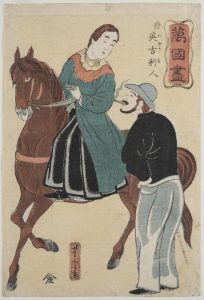
The two prints depicting women riding on horses capture not only the beauty of western fashion, but also what the artist saw as another distinctive feature of foreigners: the dominance of women over men.
In conclusion, analysis of these prints gives us great insight into 19th century Japanese response to the West. Many of the themes, tropes, and ideals showcased in this artwork are reflective of thoughts and attitudes of the time. We are privileged to be able to see these works and understand how the Japanese perceived foreigners when they encountered them for the first time.
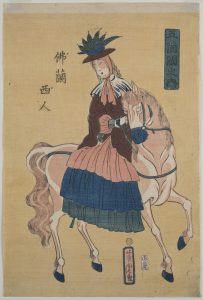
References:
1: “Boomtown, the Story: International Perspective.” MIT Visualizing Cultures, visualizingcultures.mit.edu/yokohama/yb_visnav03.html.
2: Miyoshi, Masao. As We Saw Them: the First Japanese Embassy to the United States. Paul Dry Book, 2005.
Priya Agarwal (‘22), Shannon Hiner (‘22), Camille Romano (‘22)